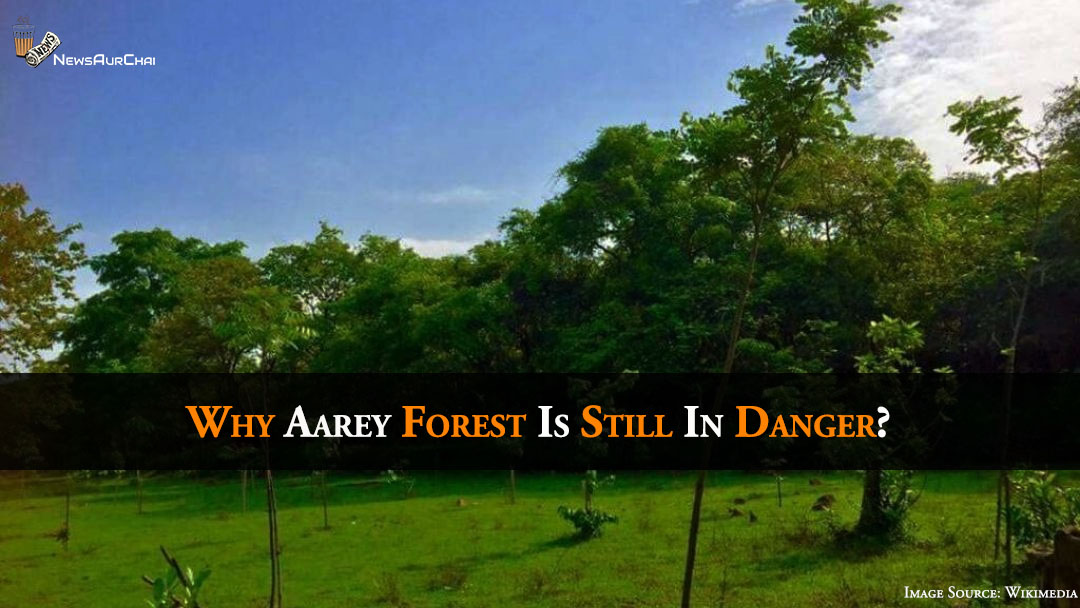
The Amazon rainforests are called the “lungs of the world”; similarly, Aarey Forest is known as the “last green lung” of Mumbai.
The 1300 hectare forest land of Aarey Milk Colony lies in the heart of the bustling metropolitan city of Mumbai and is one of the last few patches of greenery left along with Sanjay Gandhi National Park (SGNP).
It is a biodiversity-rich area hosting a wide array of flora, fauna, and is home for the leopards. However, due to rapid urbanisation, encroachment, indiscriminate felling of trees, have jeopardised the present and would likely have long-term effects on the future.
Story of Aarey Forest so far:
On June 6, 2019, 40 hectares of forest was cleared by the government to expand the Byculla zoo facilitating it with night safari.
On the other hand, Brihanmumbai Municipal Corporation’s (BMC) Tree Authority had given clearance to Mumbai Metro Rail Corporation Limited (MMRCL), operating directly under the former CM Devendra Fadnavis, to cut down and transplant 2,646 trees for the construction of Mumbai’s new metro railway.
The Mumbai Metro project is 33.5 km underground plan which has been vehemently opposed by thousands of Mumbaikars, including actors, social workers, NGOs, environmental activists, and politicians.
According to sources, “The northern end of Line 3 of the Mumbai metro, which will link Colaba, the city’s southern tip, with the Santacruz Electronic Export Processing Zone (SEEPZ), a special economic zone in the western suburb, is located in Aarey.
The MMRCL has earmarked 30 ha, or two per cent, of Aarey Colony land, for a ‘car shed’ – a Rs 900 crore project, centre above the ground that will monitor and control all metro operations once the project is completed by the end of 2021.
Around 75 lakh people—more than the entire population of a country like Bulgaria—travel in Mumbai’s local trains each day. The fully air-conditioned metro cars will ferry 13.9 lakh passengers daily, easing the load on one of the world’s largest, most densely congested railway lines.”
Mumbai is one of the rare cities to have a forest within its boundaries. The protestors claim that preserving wildlife and trees are equally crucial to easy transportation. Building a car-shed could hamper the ecological setup by transforming the area into a commercial hub, affecting the catchment area of the Mithi river flowing nearby, resulting in the potential flooding of the Mumbai airport.
However, this is not the first time for Aarey is being targeted. In 1977, around 200 hectares of forestland was cleared to accommodate the Film City. The land also hosts tribal communities who live in 29 ‘padas’ (settlements).
Asha Bhoye, belonging to the Konkani tribe, says, “We are not getting basic facilities here, and now metro authorities want to take away the jungle which belongs to us too.”
Experts from NEERI and IIT have come up with seven alternative sites for the construction, but Ashwini Bhide, managing director of the Mumbai metro rail corporation, says, “This is the most suitable land due to its size, shape and location”.
Start of protest:
Protests began when environmental activist Zoru Bhathena filed a petition in the Bombay High Court on September 2, 2019. This was backed by Stalin Dayanand, director of an NGO, actors like Shraddha Kapoor, Raveena Tandon, Singer Lata Mangeshkar, and many other famous faces turned up. ‘Save Aarey’ campaign, which was launched four years ago, was brought to life.
The MMRCL had proposed to plant six trees in place of every tree cut and had also signed a Memorandum of Understanding with SGNP to plant 23,846. They have planted over 1800 trees, but as per India Today survey, the transplanted trees were in deplorable conditions—dead, dried up, left with few stems.
Zoru Bathena said, “When we did the last inspection, over 800 trees were already dead. Only stems can be seen. Over 50 per cent of the trees transplanted are dead. There is a proper procedure which one has to follow while transplanting huge trees, which is not followed at all. My major concern is that trees we are talking about are for Metro 3 construction. However, more metro projects are going to be under development soon, so an estimate of over 10,000 trees may die over these construction projects.”
BMC Commissioner Praveen Pardeshi believes that carbon dioxide emissions would be reduced after people started availing the metro by bringing down the number of vehicles on the roads by up to 6,50,000. He also cites a report by UNFCCC stating that about 2.61 metric tonnes of CO2 will be cut down after the metro is operational.
Senior Advocate Mukul Rohatgi, representing Mumbai metro in Supreme Court, had drawn comparisons with the Delhi metro which is availed by 6 lakh commuters daily and has helped in controlling Delhi pollution.
The Supreme Court has stayed the felling of trees but has not put a stay on construction work. It was informed that a significantly large number of trees had already been chopped off and therefore no further felling of trees would be required.
“I have ordered to take back the cases filed against many environmentalists, during the agitation against Aarey metro car shed work. There will be no more cases against anyone now,” said Chief Minister Uddhav Thackeray. He also said, “I have stayed Aarey car-shed work. I will review the entire thing. I will not allow a culture where trees are cut at night”.
Greenpeace and IQAir AirVisual had released a report in March 2019, where Mumbai was marked as the most polluted city in Maharashtra and the 27th most polluted city in India, the air quality being worst in 20 years.
Activists fear that the metro project would pave the way for many more upcoming ventures disturbing the ecology beyond restoration.
Yash Marwa, a screenwriter, campaigning for the forest says, “We bring people here, make them familiar with the forest – there are many species of spiders like trapdoor spiders, the site [of the parking unit] is a leopard site. “Mumbai needs to be liveable. We need to talk about the good quality of air and life before talking about infrastructure and development.”
Bhathena points out that the ecological cost of 1 tree is Rs 23,000 per year and thus the total cost of trees felled in Aarey would approximately exceed Rs 3,500 crore.
Despite all these issues, the government is passive and ignorant, giving the impression that air quality and temperature are last on its priority list. The danger for the Aarey Forests and the whole of Mumbai is lurking over the head.





